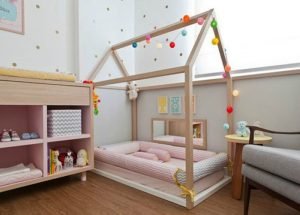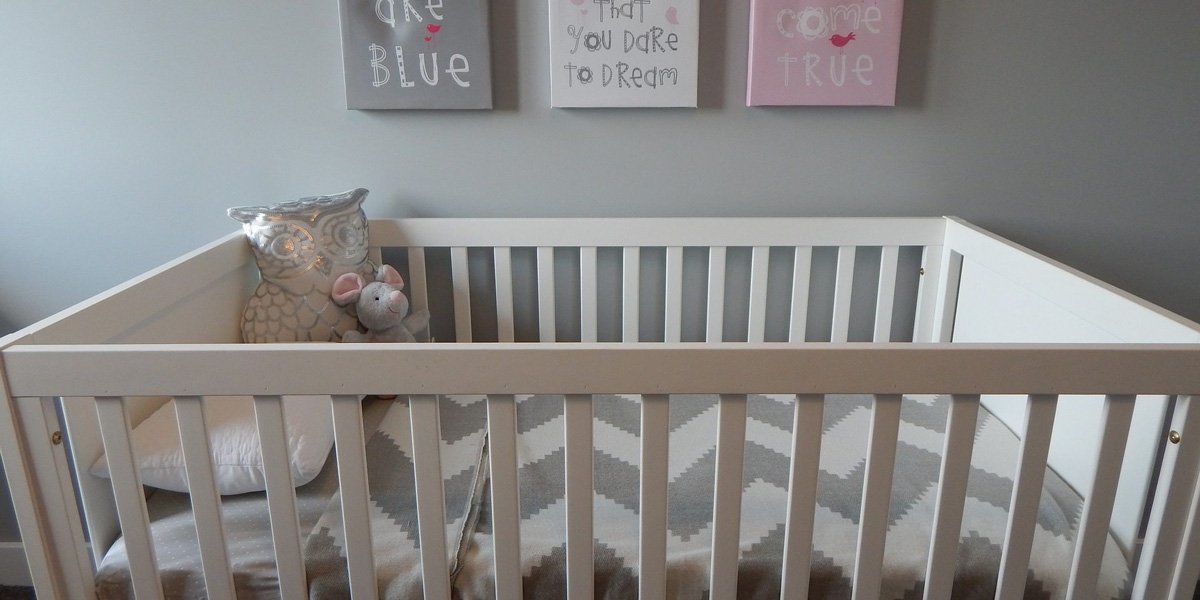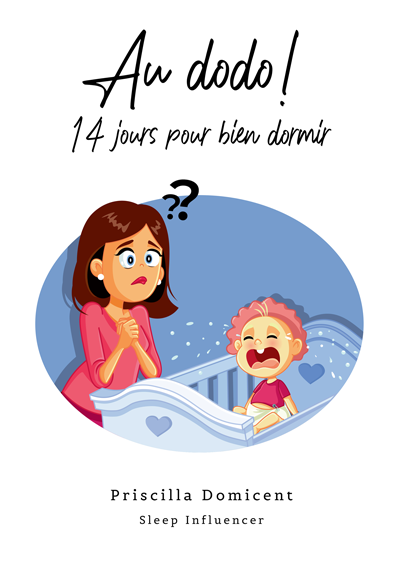You have probably discovered that your little angel is not so tiny anymore, or you have caught your toddler making an attempt to climb out of the crib. Now, you might wonder if the time has come to go shopping for a toddler bed.
Get the timing right
As a Certified Sleep Coach, I generally recommend to wait until a child is at least 2.5 years of age to transition to a ‘big kid’ bed. Around that age, kids generally show signs of maturity and have the level of verbal skills requested to understand the ‘big boy or big girl’ bedtime rules. They start to get the concept of ‘staying in bed until the next morning’.
As an alternative, you can also check if the crib rail falls below your child’s chest (the mattress should be dropped to the lowest position available) while standing in the bed. If so, you may consider it is time to transition.
Too often, parents rush to get their child out of a crib and into a bed (especially when she is trying to climb out of the crib) and struggle afterwards to get her to fall asleep and remain in her room all night long. If this is your case, I recommend to put a mattress or soft foam mats around the crib to prevent possible injuries when your child climbs out of it. To give you (even more) peace of mind, install childproof latches on chests of drawers and a gate in front of the bedroom door. Try to delay the transition as much as possible until your little one is 2.5 years.
The Montessori approach
According to Dr. Maria Montessori, we should not force our children to sleep. They are naturally able to fall asleep when feeling tired. And, if they are not tired, they should get all the freedom to explore their environment. As a result, it is recommended for babies to sleep, as from birth, in a bed without bars (of course you should co-sleep or share the room until it is safe for your child to sleep in a bed in her own room). Personally, I understand her point of view. However, I consider that we, as parents, need to rest too! For our sanity’s sake, it is important that our little one goes to bed and gives us some “Me Time”, especially at the end of the day.

The key principle of the Montessori bed is to give the child the opportunity to move around the room, allowing her to get in and out of bed alone. By putting the mattress on the floor, she won’t need your intervention and won’t get hurt by climbing out of the bed. In addition, it gives her an overall view of her room. Her vision is not restricted by bars nor bumpers.
For some parents, the Montessori bed offers some kind of relief. Their child no longer shouts in the morning or at the end of a nap to be picked up, she gets out alone. In the same vein, if she wakes up at night, rather than calling the parents, she can go to them (an advantage which, for many, can be seen as a disadvantage). Others also love that their child is given the opportunity to go to bed on her own when feeling tired. Moreover, she can stay in her room in the morning to play when she is awake.
However, the Montessori approach has its limits and can complicate bedtime. Your child needs to go through a learning period if you do not want to see her invading your nocturnal activities. If the little one really cannot tell the difference between time to play and time to sleep, I recommend to put her (back) in a crib. I am often told by parents that they consider the ‘crib solution’ as taking a step back. Unfortunately, the Montessori approach is not ideal for every single child. My goal is to bring the best level of well-being to all family members, not to make life more complicated.

Tips for transitioning from crib to bed
Based on the above information, you may have decided that now is the time to move your child from the crib to a toddler bed. Yet, at the same time, you are unsure of how to make this major transition.
Just keep in mind that making this kind of transition is a huge one; not just for your child, but for you too. That means, moving your child to a bed is not an ideal thing to do when you are actively potty training her, planning to move to a new home, or a new sibling is on the way. Making this huge change while other major things are happening will only add more stress to you and your child.
If none of that is an issue right now, then here are 7 tips on how to make this major transition as smooth as possible.
Tip #1: Talk about moving to a bed days in advance
If you use simple language and explain to your toddler that she will have a brand new bed very soon to sleep in, then it won’t be a shock. Pick an ideal moment to have a peaceful family reunion to introduce the change (i.e. Saturday or Sunday evening) and switch off all sources of potential nuisance (television, cell, computer, etc.)
Your toddler will know what she will experience ahead of time and prepare herself for the change. You can also talk about why having a ‘big kid’ bed is great.
Tip #2: Set clear rules and stick to them
During your family gathering, clearly explain what is expected from your child once the bed is installed. It’s a healthy toddler’s job to test the boundaries. Your child may ask to drink of water, have a light left on, go to the bathroom or keep the door left slightly open. Try to handle her needs before bedtime so that she doesn’t use them to avoid going to sleep.
You can mention 3 to 4 positive manners to be promoted. Avoid rules formulated in negative terms. Here are some noteworthy positive behaviors:
- Put yourself to sleep without requesting Mom or Dad to stay next to you (and hold your hand).
- Stay quietly in your bed / room until 6 AM (or until Mom or Dad come get you).
- Put yourself back to sleep if you wake up during the night.
- Go to bed quietly for naptime.
A sticker chart can be a wonderful behavior incentive. To make sure that the expected behaviors are well understood, remind every evening the rules set. Reward your child for following each night the 3 to 4 rules by giving out every morning a sticker for any positive manner adopted.
Also, you can remain in control of bedtime even when you give your toddler some freedom of choice. Let her decide which pajamas she will wear and which bedtime pal will share her bed.
Tip #3: Give your child the opportunity to be actor in this project
To make this swap even more concrete, you could take your child shopping and let her choose the new bed, bedsheets and other ‘big kid’ bedroom decorative items.
Make sure that the accessories picked out will create a comfortable, secure and not too stimulating sleep environment.
Tip #4: Place the new bed in the same spot
It doesn’t matter whether you decide to move your toddler to a twin bed or a toddler bed. It is preferable that the new bed is installed where the crib used to be in the bedroom. This will make the adjustment and acceptance of being in a big bed easier. Placing the bed in a different spot could overwhelm and distract your child as wells as disrupt sleep. That is the last thing you want to see happening.
Tip #5: Allow your toddler to try it out during naptime initially
A new bed can be really exciting for your toddler and, at the same time, scary. Giving your child the opportunity to nap in the toddler bed during the day before using it for nighttime is a great way to make the transition smoother. A new bed may seem less intimidating as a result if the toddler sleeps in it during naptime.
Tip #6: Stick to the same bedtime routine
In order to make it clear that the new bed is for sleeping, it is crucial to stick to the usual bedtime routine. Not to mention, kids feel safe while they are on routines since they know what to expect and which help establishing healthy sleep patterns. Therefore, putting your child to bed by applying the same rituals and at the same time each night will help the transition happen in a smoother way.
You can also tell your little one that you will check on her a couple times before you go to sleep. This can provide your toddler extra reassurance.
Tip #7: Be patient and consistent
You might face new struggles following the transition. The removal of the crib bars could be associated to the disappearance of bedtime boundaries. Set clear objectives and give your toddler the time to understand and apply the new set of rules. Getting upset when your child keeps you awake at night is understandable. When you are tired, you become easily annoyed and impatient. However, try to remain positive and understanding. A negative response to a child’s behavior can sometimes make a temporary sleep problem worse.
Whatever sleep training or sleep coaching method you decide to apply, consistency is the key success factor. Therefore, make sure to think thoroughly about the positive manners you want to reinforce and stick to your approach during the whole crib-bed transition. Every child needs someone to believe in them and show them the right path. That someone is first an foremost you (the parent).
Prepare yourself for some bedtime and night struggles
One thing to keep in mind that your toddler will discover that there is freedom when it comes to being in a bed. Therefore, she will probably get out of bed at times when she should be sleeping.
Some psychologists associate sleep disturbances to the Oedipus Complex. Around 3 years old, children tend to walk into the living room or the parents’ bedroom while they are sleeping and climb between them. Toddlers tend to refuse to sleep alone and try to break parental one-on-one home evenings. It is also a period during which nightmares with huge monsters coming to devour them could appear.
When your little one jumps out of her bed, lead her calmly back to the room and tell her she should remain quietly in bed and fall asleep on her own. Do not overreact to avoid stimulating your child. She might consider that getting any attention is better than getting none. Once she is back in bed, tell her briefly what a good girl she has been, remind her eventually about the sticker chart and leave the room.
If you are getting ready to transition your child from the crib to bed, be sure to utilize the tips mentioned above and best of luck with the change!
If you would like to get more information on how to improve the quality and/or the quantity of your child’s sleep (and yours at the same time), do not hesitate to schedule a 15-minute preliminary consultation. It is a totally FREE & NON-BINDING offer!










One of the toughest things about having your children share a room is that all privacy disappears. While this might not bother young children, it may bother older kids
This was a really helpful read.
I especially love the tip to actively involve the child in the transition, say by choosing the bed when you go shopping. This will help them feel a sense of ownership of all the changes going on and motivate them to be more excited and cooperative.